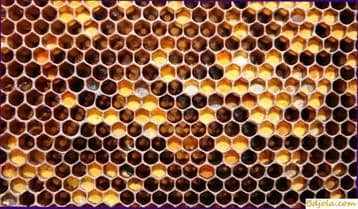
Natural food for bees and their brood are honey and pepper. The issues of harvesting, quality control and storage of honey reserves are developed in detail, which can not be said about perge. At the same time, because of its lack, substitutes are used.
Flower pollen, selected from bees in the form of updates, is a semi-finished product. Folded into honeycomb cells with the addition of honey, after going through the process of fermentation, it turns into perga – a high-grade protein feed. It is harvested in order to use it in the spring, as well as stocks of honey. Such an event reduces the need for sugar when feeding bee families in the spring of next year. On natural fodder stocks, more complete individuals grow.
Bees bring in pollen as pollen in the course of the entire beekeeping season, but in different quantities. It depends on the presence of Perga in the hives, the pollen plants in the respective areas, the nutritional value of the pollen. We noticed that bees are more likely to collect it from the nutwood of forest, fruit and berry crops.
In the absence of a pollen bribe and Perga stocks in hives, the development of families is slowing down. Therefore, beekeepers feed them with sugar-perga paste. It includes pollen harvested in the form of pollen, selected with the help of pollen-catchers, dried, drenched with honey and sprinkled with sugar. Use and substitutes perga: dry brewer’s yeast, cow dried milk powder, special blends, which include soya fat-free flour, fine grinding as a protein component. Application of the latter requires additional funds, labor costs. Substitutes do not affect the development of bees as effectively as perg.
Constant pollen and nectarine bribes are organized from year to year, planting near the pike the pollen and nectariferous trees and shrubs (hazel nuts, willow goats (male specimens), dogwood).
In the Carpathian region, the practice of pasturing apiaries early in the spring to the mountains to increase the strength of bee colonies. Iva kozya on the spur of the mountains in many places forms a strong thicket. On the southern slopes, it blooms a week earlier than on the northern slopes, which provides long-lasting honey and pollen bribes.
In order to activate visits of red clover to testes by bees, the experimental beekeeping station recommended that one of the cutting honey-comb honeycombs be removed from the nest of bees. At the same time, the family increases the collection of pollen and nectar, the bees are more likely to visit a larger number of plants in order to compensate for selected fodder stocks.
In the United States, since 1898, a feeding superstructure has been used, in which feed stocks are placed for winter and spring. It is located above the nest housing of a multi-hull. According to the conclusion of AI Ruth (1927), the stern extension made a revolution in American beekeeping.
In Ukraine, they practiced harvesting honey combs for the winter and spring of the next year in the period of honey collection from early-age honey-plants: white acacia, meadow motley grass, sainfoin.
So, in the apiary we prepared the main stocks of honey for the winter in lounges near the brood, three or four full-copper honeycombs per family.
Before moving to the main honey collection with buckwheat, they were taken out and stored in cabinets in a storage room above the winter hut, where they periodically examined and fumigated from moths with sulfur dioxide. Upon returning the apiaries from the nomadic movement the honeycombs were returned to the same hives, from which they were taken away. Stocks of fodder up to the norm were adjusted by feeding the families with sugar syrup.
We noticed that in June, when a beehive was delayed with the rearrangement of the hulls of a multihull hive, the bees filled the honeycomb with pollen from the lower shell after the release of the brood. We put this body on the upper shell with brood. In the period of honey collection the bees were poured with honey and the cells were sealed with wax lids. In this form, honey-comb cells were stored.
Плесень на рамках с медом. Подкормка пчел на зимовку.
Feeding base of beekeeping